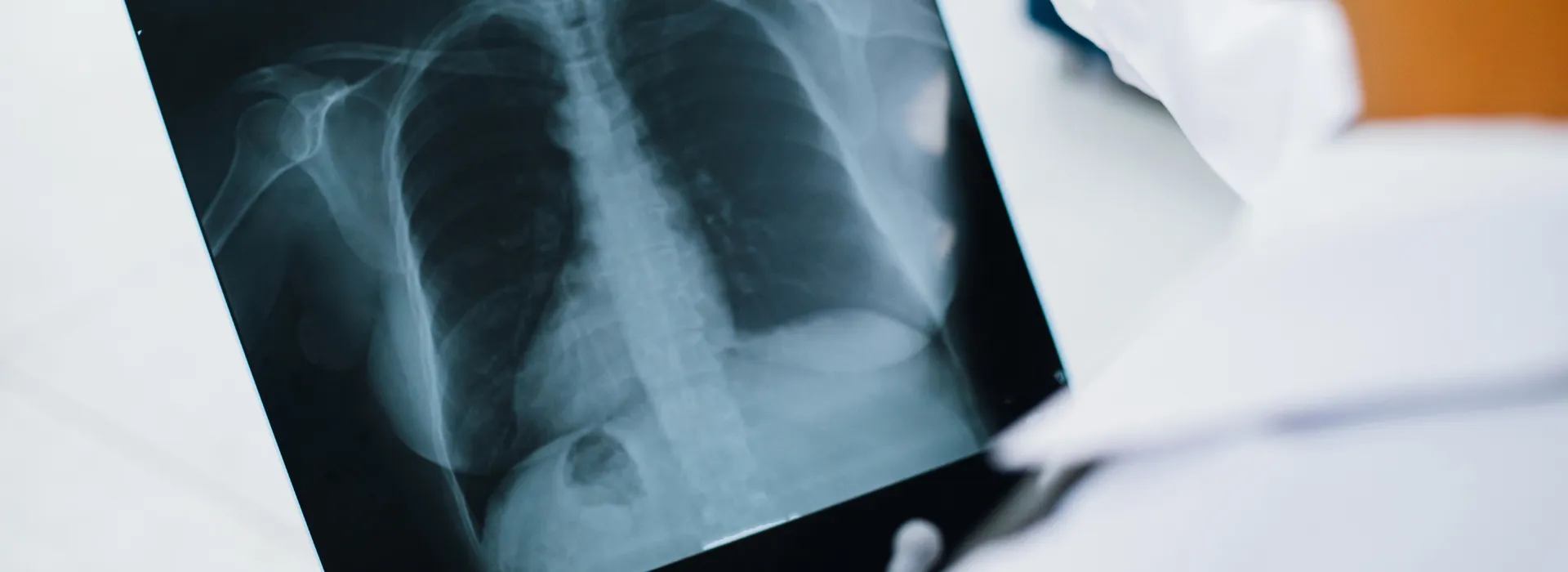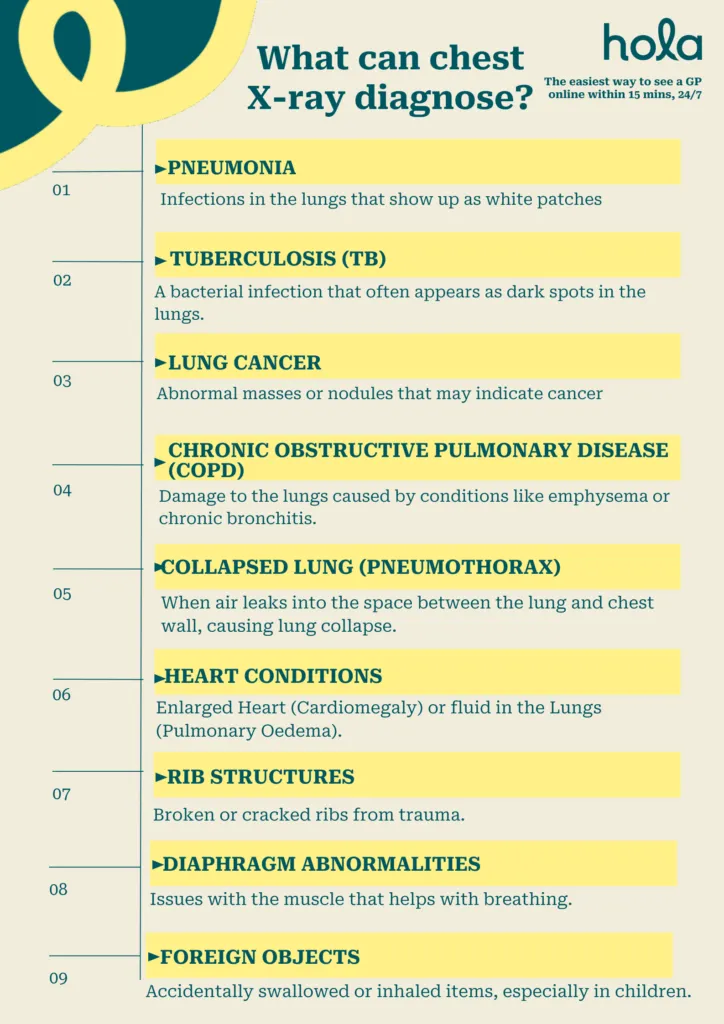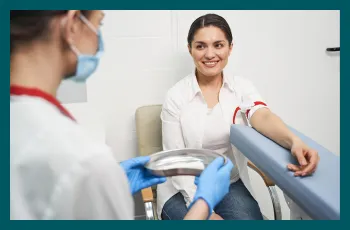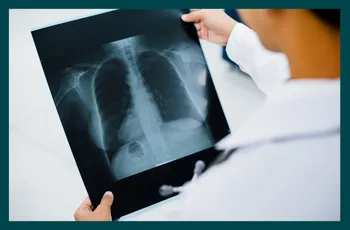What can a chest X-ray diagnose? Everything you need to know
Written by Dr Nelson Lau, MBBS FRACGP, GP & Digital Health Specialist.

Contents

A chest X-ray is one of the most common imaging tests used by doctors to get a closer look at your lungs, heart, and surrounding structures. Whether you’re experiencing unexplained chest pain, a persistent cough, or difficulty breathing, this quick and painless procedure can provide crucial insights into what’s going on inside your body.
In this guide, we’ll walk you through everything you need to know about chest X-rays, from what they can diagnose to how to prepare for one.

What is a chest X-ray?
A chest X-ray is a type of medical imaging that uses a small amount of radiation to capture images of the organs and structures inside your chest. It’s a fast, non-invasive test that helps doctors identify lung conditions, heart issues, fractures, and other abnormalities. During the procedure, X-rays pass through your body and create images based on how different tissues absorb the radiation. Bones appear white, air-filled lungs look black, and soft tissues show up in shades of grey.What can a chest X-ray diagnose?
Chest X-rays are used to detect a wide range of conditions, including:Lung conditions:
- Pneumonia – Infections in the lungs that show up as white patches.
- Tuberculosis (TB) – A bacterial infection that often appears as dark spots in the lungs.
- Lung cancer – Abnormal masses or nodules that may indicate cancer.
- Chronic Obstructive Pulmonary Disease (COPD) – Damage to the lungs caused by conditions like emphysema or chronic bronchitis.
- Collapsed lung (Pneumothorax) – When air leaks into the space between the lung and chest wall, causing lung collapse.
Heart conditions:
- Enlarged heart (Cardiomegaly) – A sign of heart disease or heart failure.
- Fluid in the lungs (Pulmonary Oedema) – Often due to heart failure.
Other conditions:
- Rib fractures – Broken or cracked ribs from trauma.
- Diaphragm abnormalities – Issues with the muscle that helps with breathing.
- Foreign objects – Accidentally swallowed or inhaled items, especially in children.

How to prepare for a chest X-ray?
There’s minimal preparation required, but here are a few things to keep in mind:- Wear loose, comfortable clothing and avoid garments with metal buttons, zippers, or jewellery that could interfere with the image.
- You may be asked to change into a hospital gown.
- Let the technician know if you’re pregnant (more on that below).
- Inform your doctor if you have any metal implants that could affect the X-ray results.
What does the equipment look like?
A chest X-ray is typically done using a large X-ray machine in a hospital, clinic, or radiology centre. The machine consists of:- An X-ray tube, which emits the radiation.
- A detector or film plate positioned behind you to capture the image.
X-ray needed? Get your radiology referral online in 15 minutes.
See a Doctor now
Available 24/7, across Australia.
How does the procedure work?
How is the procedure performed?
- You’ll be positioned in front of the X-ray machine—either standing, sitting, or lying down.
- A technologist will ask you to hold still and take a deep breath to get a clear image.
- The X-ray machine will emit a brief pulse of radiation to capture the image.
- You may need to change positions (e.g., a side view) for additional images.
- The entire process takes just a few minutes.
What will I experience during and after the procedure?
- The X-ray itself is painless—you won’t feel anything as the radiation passes through your body.
- You may be asked to hold your breath for a second to avoid blurring the image.
- After the test, you can resume normal activities immediately—there’s no downtime.
Who interprets the results and how do I get them?
A radiologist (a doctor specialised in medical imaging) will analyse your X-ray and send a report to your physician.- Results are usually available within a few hours to a couple of days.
- Your doctor will review the findings and discuss any necessary follow-up tests or treatments. If your results are urgent, the radiologist may notify your doctor right away.
When should I call my doctor?
You should reach out to your doctor if:- Your symptoms are worsening despite treatment.
- You experience new or severe pain in your chest or ribs.
- You have trouble breathing or persistent coughing.
- Your doctor suggests further testing based on the X-ray results.
How telehealth can help with a chest X-ray
Telehealth plays a crucial role in accessing and managing chest X-rays, making the process more convenient and efficient. Here's how:
- Telehealth appointment – If you're experiencing symptoms like persistent cough, chest pain, or shortness of breath, an online doctor can assess your condition and provide a referral for a chest X-ray without needing an in-person visit. Along with referral, you can also access telehealth medical certificates online.
- Online prescription – If your X-ray indicates an infection or another treatable condition, the doctor can issue online scripts.
- Remote review – Once your chest X-ray is completed, a health practitioner can review the results online and explain the findings, helping you understand any further steps required.
- Specialist referrals – If further evaluation is needed, telehealth services can connect you with a specialist, such as a pulmonologist or cardiologist, for advanced diagnosis and treatment.
Benefits vs. risks of a chest X-ray
Benefits:
- Quick and painless – The procedure takes only a few minutes.
- Non-invasive – No needles, incisions, or contrast dyes are needed.
- Effective diagnosis – Can detect a wide range of lung and heart conditions.
Risks:
- Minimal radiation exposure – The amount of radiation is very low, but repeated X-rays should be limited when possible.
- False positives/negatives – Some conditions may require additional imaging (e.g., CT scan) for confirmation.
Should I have a chest X-ray if I’m pregnant?
If you’re pregnant or suspect you might be, inform your doctor before the X-ray. While the radiation exposure is low, doctors usually avoid X-rays during pregnancy unless absolutely necessary. In such cases, a lead shield may be used to protect the baby.Do I need a referral for a chest X-ray?
In most cases, yes. A doctor must order the X-ray based on your symptoms and medical history. However, some urgent care centres and imaging clinics may allow walk-in chest X-rays without a referral. If you’re unsure, check with your doctor or local imaging centre.Final thoughts
A chest X-ray is a simple yet powerful diagnostic tool that can reveal a wide range of health conditions affecting the lungs, heart, and surrounding structures. While the test is quick and painless, its results can be life-saving. If you’re experiencing persistent chest pain, trouble breathing, or other concerning symptoms, don’t hesitate to consult your doctor. Early detection can make all the difference in your treatment and recovery.X-ray needed? Get your radiology referral online in 15 minutes.
See a Doctor now
Available 24/7, across Australia.
What we treat
- Cough
- Nausea & vomiting
- Fever
- Hayfever
- Fatigue
- Sore throat
- Acne
- Hair loss
- Gout
- Eczema
- Rosacea
- Sunburn
- UTI
- Erectile dysfunction
- Contraception
- Morning sickness
- Morning after pill
- Prostate health
- Anxiety
- Depression
- Stress
- Grief & loss
- Antidepressants
- Premature ejaculation
- Asthma
- Blood pressure
- Blood thinners
- Diabetes
- Cholesterol
- Migraines & headaches
- Allergies
- Body ache
- Heartburn & reflux
- Sleep disorder
- Pain relief
- Gastro
Related Articles
Disclaimer
This blog is for general informational purposes only and does not indicate that Hola Health provides all treatments or preventive measures mentioned. It is not intended to be a substitute for professional medical advice. Always seek the guidance of your doctor or other qualified health professional with any questions you may have regarding your health or a medical condition. For emergencies please immediately contact 000. Any medical topics discussed are intended to educate, not to imply availability through Hola Health.

 Facebook
Facebook  X
X  Copy Link
Copy Link



